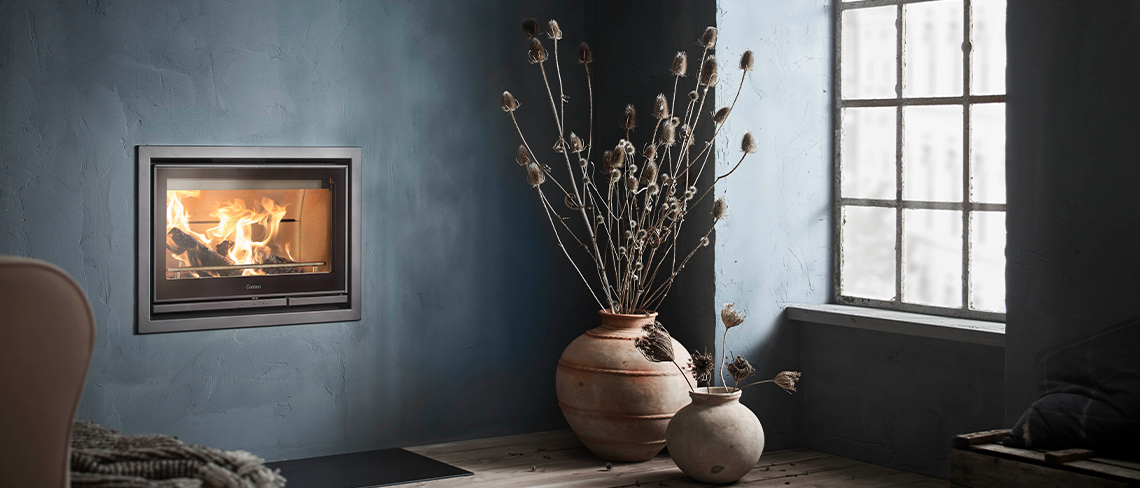
- Tips on choosing the right appliance, the right fuel, and correct usage of your wood burner to maximise efficiency and minimise impact on the environment
- The importance of wood as an efficient, renewable and low carbon energy source
- Wood burners vs Open fires: the stats
There are few things in life more comforting and mesmerising than the long, lazy flames and crackling sound of a freshly lit wood fire, however, there is some confusion surrounding the impact of wood burning stoves on the environment and the efficiency and sustainability of firewood as a fuel source.
With air quality an ever growing issue, especially in urban areas, it is vital that government, stove manufacturers, dealerships and fuel suppliers alike, work together to educate Brits that by following best practice and making the right choices when it comes to wood burners and fuel, stove owners can ensure that they are getting the best possible performance from their appliance whilst also playing their part in protecting the environment.
Contrary to popular opinion, when used and maintained correctly, the right appliance can provide an efficient, cost effective and sustainable domestic heating solution. Likewise, firewood is a highly efficient and low-carbon energy source.
In this comprehensive guide to wood burning stoves, the aptly named Phil Wood of Swedish manufacturer, Contura, highlights the benefits of wood burning stoves, provides important tips to help minimise emissions and dispels some of the common misconceptions surrounding the use of wood vs. fossil fuels.
Phil says: “Defra’s decision to ban the sale of house coal and wet wood in the UK was a necessary step when it comes to minimising fuel emissions from domestic fires. As for appliances, Ecodesign Ready wood burning stoves already meet stringent requirements in relation to emissions reduction and as such, are approved for use in smoke control areas.
“Wood burners that meet government regulations are a completely viable option for homeowners looking to upgrade an old stove, replace an open fireplace or even switch to wood as their main energy source. Installing a stove will heat a home more efficiently than an open fire, helps to significantly reduce particulate emissions, and, for those switching from gas or electric, can help to save money on energy bills longer-term.”
Why is wood a good fuel option?
“Unlike coal or natural gas, wood is a low-carbon fuel. This means that burning wood results in a relatively small net release of carbon dioxide into the atmosphere, which is then re-absorbed when new trees grow. This effectively balances out the combustion of bioenergy.
“As such, when changing from smokeless or mineral fuels to burning wood, this contributes to a reduction in carbon emissions.
“Unlike fossil fuels such as coal, crude oil and natural gas, wood is a renewable energy source. A renewable resource is defined as a natural resource which can be replenished to replace the portion depleted by usage.
“Wood is renewable in that a tree cut for fuel will naturally be replaced by a younger tree that grows or is planted in its place. However, it is also important to consider the concept of sustainable forest management; both locally and worldwide…
“Most firewood is produced from thinning the forest to provide space, nutrition and light for thicker, more established trees to prosper. Localised coppicing helps to ensure ‘low fuel miles’ as wood is transported to areas nearby, within a 30 to 100 mile radius, rather than sourced from forests abroad.”
How efficient is wood burning?
“Using firewood contributes to fuel independence as it can nearly always be sourced locally, within a 30-100-mile radius, which means it extremely efficient in fuel miles terms and those purchasing firewood are also supporting the local economy.
“In the case of rural properties that do not necessarily want to heat all spaces at all times, local space heating using firewood is the most efficient heating solution.
“Just two logs per hour are required to keep a wood burner going, whilst eight logs are needed to burn for an hour in an open fire.
“Similarly, a wood burning stove is 60 percent more efficient at heating the home as heat transfer is convected into the room rather than being lost up the chimney in the case of conventional open fireplaces.”
How can I minimise my emissions?
“Investing in a modern, clean burning Ecodesign Ready stove can reduce emissions by up to 90% compared to a traditional open fire for example.
“Ecodesign Ready stoves have been engineered to burn wood more completely. The targeted introduction of combustion air at higher levels in the fire box of the stoves reignites the combustion particles before they can leave the stove. This technology reduces particulate emissions by 90 percent compared to an open fire or 80percent compared to a stove of 5-10 years old. It can also lead to significant reductions in Carbon Monoxide, Nitrous Oxides and Organic Gaseous Carbon compounds (OGCs).
“If you have an open fireplace or an out of date wood burner, consider replacing these with a wood burning stove that meets the Ecodesign Ready regulations. To optimise efficiency, it is important to choose a size of stove to suit the room size you want to heat.
“The stove should be cleaned out regularly to remove excess ash, soot and debris, as this will ensure a more efficient burn and minimise smoke. Get your stove serviced by a professional chimney sweep once a year, as this will troubleshoot any issues and ensure the stove is working at its best year-round.
“To minimise emissions, it is also crucial that you burn the right fuel, learn to light the fire correctly and refuel the stove at the right time. More on these points to follow…”
How do I choose the best firewood?
“Purchase the best seasoned, dry or kiln-dried wood that you can afford from a recommended supplier.
“You can be sure of the wood’s quality and origin by buying from accredited British suppliers. The UK’s woodfuel accreditation scheme, Woodsure, issues a ‘Ready to Burn’ certification mark to wood suppliers that can demonstrate that their logs have an optimum moisture content between 12 and 20 percent. Look out for this label for your quality guarantee.
“Using kiln dried wood or wood with a moisture content below 20 percent will generate the correct heat and the correct flame, ensuring maximum efficiency from your wood-burning stove and crucially, minimising smoke.
“Never burn wet, treated, polished, varnished or oiled woods or waste woods such as pallets, furniture or fencing. Also avoid or mixed wood products (commonly found on building sites), as these will tend to give off unpleasant fumes, can damage the stove flue, and will produce a lot of black or grey smoke.
“Good quality hardwood species such as ash, oak, beech or birch will burn the cleanest and longest with a bright flame.
“Avoid soft woods such as pine, firs and cypress, which burn too quickly and produce more smoke.”
What should I look for when choosing an appliance?
“With so many different stove models available, it can be difficult to know which might suit your interiors or heating needs.
“There are a number of factors to consider before selecting and installing a wood burner. Whilst aesthetics are, of course, important, it is essential to look at the size of the stove, its heat output, and the technology of the stove model (convection and clean burning systems, efficiency, practicality, ease of use and overall performance).
“UK air quality is an issue of growing concern. However, we can significantly reduce the level of emissions from burning firewood simply by replacing open fires and old wood burners with Ecodesign Ready stoves. This is where the ‘quick win’ in emissions reduction can be made.
“It is also important to consider stove size and heat output to ensure maximum efficiency and minimise wastage of energy. This will depend on the size of the space you are looking to heat. For a 25 metre squared room for example, you would need to go for a stove with an output of approximately 5kw, whilst for a space of 120sqm, you’ll need a model with a bigger chamber that provides an output of 7kw.
“For large or particularly cold spaces, sand and soapstone-clad stoves or those equipped with heat-retaining bricks work well in terms of efficiency, as the materials retain heat over a longer period – even after the fire has been extinguished.”
What about cleaning and maintenance?
“Proper function of a stove, its seals, gaskets and the chimney draw, can all affect emissions. When everything works optimally, the appliance will run at its cleanest and most efficient.
“And it is maintenance that will achieve optimum performance. The chimney, flue and stove should be swept professionally at least once a year. An annual check is crucial to troubleshoot any issues, check all parts are functioning correctly and remove any soot and blockages that may be affecting the efficiency and emissions of your stove. Set an annual reminder to get your annual chimney sweep appointment booked in.”
How should I light the fire?
“For the best and most efficient burn, it’s important to ensure it is lit correctly.
“To use a wood burner correctly, you need to warm the stove and chimney chamber through first, rather than trying to create a roaring fire and a lot of heat straight away. It’s better to build the fire up progressively. Think of lighting the stove as a similar process to pre-heating an oven or starting a car in winter; the engine needs time to warm up properly before it drives efficiently.
“A roaring fire is more often the result of loading too many logs in one go. You shouldn’t overload the space but use it as efficiently as possible. As a rule, a wood burner requires 2-3 logs per hour.
“Most of us are familiar with putting kindling at the bottom of the fire, but this makes it more difficult for the fire to get going at the start, leading to an inefficient burn and more smoke.
“The lesser known practice of ‘top-down lighting’ (placing kindling at the top) is far better for the environment as it causes less pollution and fewer emissions. The kindling will catch more slowly, however, as it’s at the top of the fire it will also generate less smoke. Lighting the kindling in this way is therefore more environmentally friendly.
“Modern wood firing technology (Ecodesign compliant product) uses complete combustion for a better heating economy and a clean, low-carbon burn. As long as you prep the fire correctly and refuel it at regular intervals, it will provide clean and consistent heat.
“Remember that not all stoves are the same and that it’s important to always follow the lighting instructions in your product manual for instructions specific to your wood burner. This guide will also advise you about adjusting the air vents to maintain the correct air flow and combustion temperature.”
How should I refuel?
“To ensure no smoke escapes into the living space, refuelling should only be done once the fire has burnt right down to glowing red embers and no yellow flame is present in the firebox.
“The door should be opened ajar slowly, allowing the firebox to pressurise a little with the incoming air flow, before opening fully to load more fuel; usually 1-2 logs.
“Open the airflow to ensure the fresh load of fuel catches quickly and efficiently and then slowly lessen airflow to increase the burn time of the fuel.”
What is the difference between using an open fire and wood burner?
“A wood burning stove is far more efficient than an open fireplace, using less wood, it is cheaper to run and leads to a better fuel economy.
“To significantly improve both indoor and outdoor air quality, it is strongly advisable to replace an open fireplace with a closed wood burning stove.
“In order to both minimise emissions and benefit from enhanced efficiency, invest in a modern, cleaner burning, Ecodesign Ready wood burner.”
The stats
- An Ecodesign ready wood burning stove reduces particulate emissions by 90 percent compared to a traditional open fire and 80% compared to a 10 year old stove.
- Two logs of similar characteristics will burn for up to one hour in a wood burning stove, compared to only 15 minutes on an open fire.
- Compared to open fires, Ecodesign Ready stoves reduce the emission of:
- Organic Gaseous Carbon compounds (OGCs) by 70 percent
- Nitrous Oxide (NOx) 34 percent
- Carbon Monoxide (CO) by 33 percent
- Migrating from an open fireplace to a flue connected to a stove will halve the deemed air loss from the room.
- 80 percent of the heat generated by a wood burning stove is convected and radiated into the room, compared to only 20% in the case of an open fire.
“A replacement scheme to upgrade old stoves would be a logical step to tackle the issue of emissions from wood burners. The fact remains that burning a sustainable and renewable energy source such as wood offers a better heating economy and helps to reduce the carbon footprint of our homes in the long-term as it reduces the reliance on energy from power stations used to power central heating.
“The UK will need a balanced, wide and sustainable mix of heating solutions for all types of domestic properties in the coming decades; the industry has already shown innovation and will continue to strive to introduce further improvements in the future, assisting with emission reduction and a lower carbon economy.”
The final checklist to maximise efficiency and reduce emissions
- Only burn wood on an Ecodesign Ready stove (look for the Ecodesign Ready label or consult with your dealer).
- Use kiln dried wood or wood with a moisture content below 20 percent. Purchase the best wood you can afford from a recommended supplier (look out for the Woodsure ‘Ready to Burn’ label which guarantees a moisture content between 12 and 20 percent).
- Hardwood species such as oak, ash, beech or birch will burn the cleanest, longest, with a nice bright flame and minimal smoke.
- Use the top down lighting technique and maintain the correct combustion temperature in the stove.
- Refuel only once the wood has burnt down to red embers and there is no yellow flame.
- Ensure your chimney is swept and stove checked annually.
For more information, visit www.contura.eu.
-Ends-
Notes to editors:
Rooster PR will coordinate comment, interview and profile opportunities for Contura UK Country Manager, Phil Wood.
For further press information, please contact:
Elsa Findlay | Jo Kendall | Julie Aguilera
Rooster PR
T: +44 (0)20 3440 8930
E: [email protected]
About Contura:
Contura is Europe’s leading manufacturer of wood burning stoves, offering an extensive range of classic and contemporary wood burners; from traditional insert stoves suitable for existing fireplaces, to freestanding statement models made with innovative materials such as soapstone.
Starting at £1,095, Contura stoves are premium yet affordable. Award winning, timeless Swedish design means the products complement or enhance any style of home, whilst also offering outstanding performance, maximum efficiency, practicality and ease of use.
Designed and assembled at the factory located in Markaryd, Sweden, and manufactured to the highest standards, Contura stoves are highly energy efficient, offering powerful convection, superior combustion technology and clean burning systems. Currently, 95% of Contura stoves are DEFRA Clean Air Act exempt and thus approved for use in Smoke Control Areas.
Contura stoves can be purchased through a network of 165 independent retailers nationwide.
Contura is part of the NIBE group, a Swedish manufacturing company producing world class solutions in sustainable energy across Europe, North America, Asia and Australia.
Contura is a founding member of the Stove Industry Alliance (SIA) in the UK.
For more information please visit www.contura.eu.






